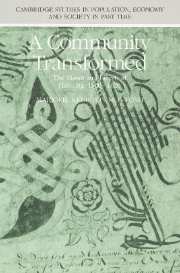Book contents
- Frontmatter
- Contents
- List of figures
- List of tables
- Acknowledgements
- Abbreviations
- Introduction
- 1 Life and death
- 2 Changing economic patterns
- 3 Religion
- 4 Facets of a society in transition
- 5 Havering's declining independence
- 6 Overt conflict, 1607–19
- Conclusion
- Appendices
- Bibliography
- Index
- Cambridge Studies in Population, Economy and Society in Past Time
1 - Life and death
Published online by Cambridge University Press: 11 October 2009
- Frontmatter
- Contents
- List of figures
- List of tables
- Acknowledgements
- Abbreviations
- Introduction
- 1 Life and death
- 2 Changing economic patterns
- 3 Religion
- 4 Facets of a society in transition
- 5 Havering's declining independence
- 6 Overt conflict, 1607–19
- Conclusion
- Appendices
- Bibliography
- Index
- Cambridge Studies in Population, Economy and Society in Past Time
Summary
Demographic patterns provide the context of every community's life. The size of the population, special factors such as unusual rates of mortality or geographic mobility, the composition and functions of the household unit, and the course of the life cycle all form a setting within which other features develop and are expressed. In Havering, demographic considerations contributed both to change and to continuity. A doubling of the total population between 1500 and 1620, a peculiarly high death rate, especially in Romford, and the constant arrival of newcomers at every economic level contributed to the alteration of many local patterns. The disappearance of well-established local families, especially those of middling status who had previously dominated Havering's public life, and their replacement by outsiders helped to disrupt the earlier sense of a shared purpose within the community. The consolidation of power by a few dominant families was assisted by the high degree of mobility among those beneath them. Newcomers and travel helped to integrate Havering into a wider cultural and social context, while lack of respect for Havering's traditional autonomy among immigrants contributed to the decline of its legal and administrative privileges. Yet in other respects demographic factors provided stability. The household unit retained its central position, furnishing a solid private base for the public transformations going on around it. The shared experiences of most local people as they moved through the stages of the life cycle furnished underlying continuity throughout the sixteenth and early seventeenth centuries. Although new functions were added to the household and a few elements within the life course were modified, these changes were minor.
- Type
- Chapter
- Information
- A Community TransformedThe Manor and Liberty of Havering-atte-Bower 1500–1620, pp. 8 - 91Publisher: Cambridge University PressPrint publication year: 1991

